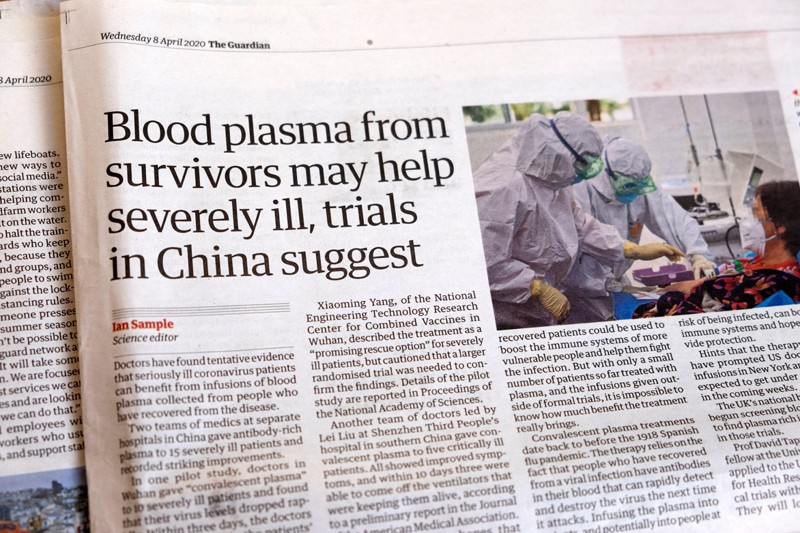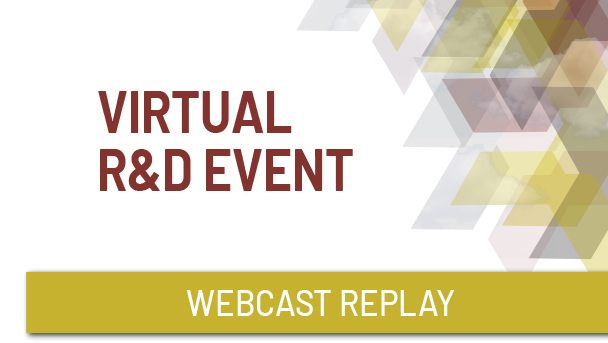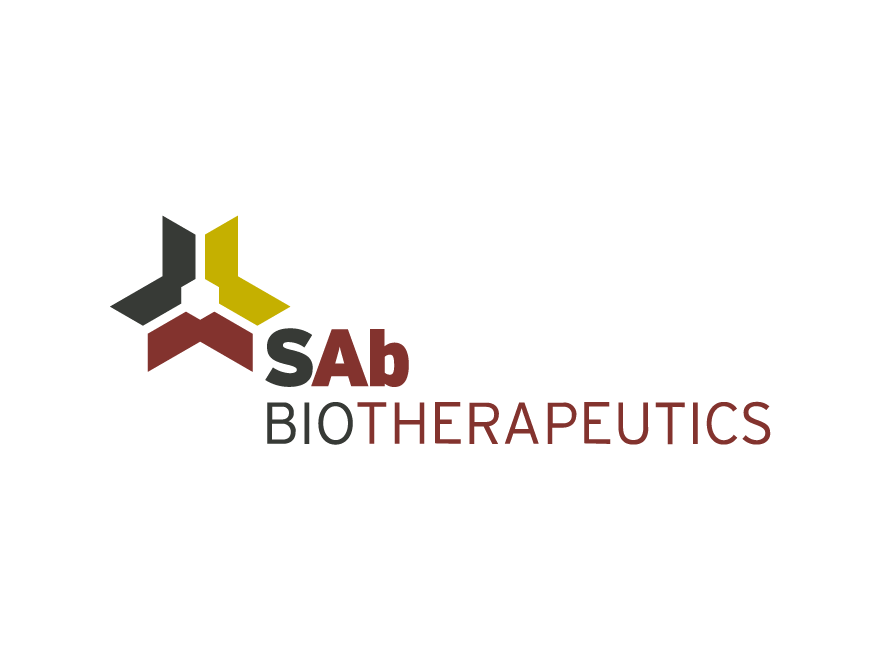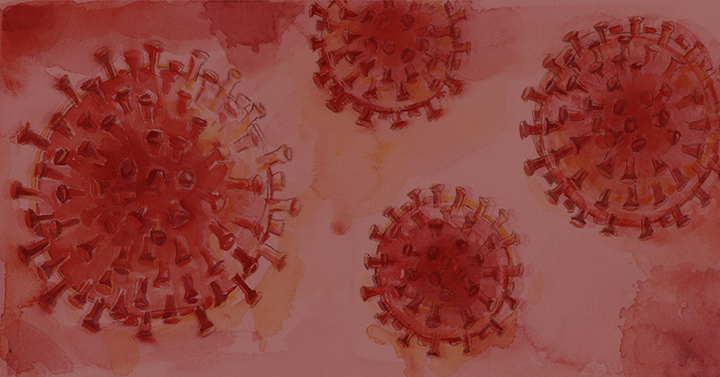May 1, 2020 | Cormac Sheridan
Antibodies from blood donated by people who recovered from the illness and hyper-immunoglobulins are becoming treatments of choice for COVID-19, with recombinant polyclonal antibody approaches to follow.
A group of US academic researchers has sparked a nationwide effort to encourage people who have recovered from COVID-19 to donate plasma, which will be used to treat patients across the country. The convalescent plasma program was instigated by physicians and investigators from 40 institutions, including the Mayo Clinic, Johns Hopkins University, Washington University, Einstein Medical Center and the Icahn School of Medicine at Mount Sinai, among many others working closely with the US Food and Drug Administration (FDA) and industry partners. The UK’s National Health Service launched in April a program across its 23 main blood centers to collect convalescent plasma for testing in planned clinical trials. At the same time, a consortium of industry players — Takeda, CSL Behring, Biotest, Bio Products Laboratory, LFB, Octapharma and Microsoft — has come together to develop an unbranded polyclonal antibody product: hyperimmune globulin (H-Ig) purified from the pooled plasma of donors who have recovered from COVID-19. Elsewhere, convalescent plasma treatment is getting a twenty-first century facelift, with two efforts attempting to capture the entire human antibody repertoire against SARS-CoV-2 in recombinant platforms: a collaboration between SAb Biotherapeutics, CSL Behring and the US Biomedical Advanced Research and Development Authority (BARDA) working to introduce artificial chromosomes into cattle to produce human antibodies and an effort by GigaGen to introduce an antibody library against SARS-CoV-2 into a mammalian cell line. The goal is to scale up polyclonal antibody manufacturing to produce treatment cocktails directed against the betacoronavirus causing COVID-19. But, as with every other response to the pandemic, scaling these efforts to the point where they can have a meaningful and immediate impact presents a complex set of problems.
The first reports on the use of convalescent plasma transfusions to treat COVID-19 came from a couple of case series rather than properly controlled trials, but their outcomes were encouraging (Table 1). Five patients at the Shenzhen Third People’s Hospital in Shenzhen, China, were treated with convalescent plasma. Of these, three were discharged and the other two were stable as of 25 March, despite having been in respiratory failure before the transfusion. A second study followed ten patients with severe disease, recruited from three hospitals in Wuhan, China. By data cutoff, three had been discharged and the other seven were ready for discharge. In contrast, among ten matched historical controls with similar baseline characteristics, three died, one improved and six stabilized — meaning their condition neither improved nor worsened.
Data from additional studies in China and South Korea are slowly starting to flow, but many clinical centers are not waiting for further evidence, given the urgency of the crisis and the lack of proven therapeutic alternatives. “This option rapidly became the best option without really demonstrating that it would work,” says Arturo Casadevall, chair of molecular microbiology and immunology at Johns Hopkins University, who kick-started the US effort to deploy convalescent plasma. “The likelihood of harm is very low relative to the possibility of benefit,” he says.
It is, however, important to understand how best to deploy convalescent plasma to treat COVID-19. “The world is going to be dealing with this for a while longer,” says Casadevall. “We really need to figure out how to use antibody therapies.” So far, the emphasis has understandably been on patients with severe disease who have run out of treatment options. Johns Hopkins is one of the few centers planning to embark on a prospective prevention trial, led by associate professor of medicine Shmuel Shoham, to assess whether convalescent plasma can confer passive immunity on recipients. “Antibodies always work best either prophylactically or early,” says Casadevall. Encouragingly, the initial reports from China suggest the therapy may also work during the later phases of the disease, when acute respiratory distress syndrome is already established. In the Shenzhen study, patients received convalescent plasma between 10 and 22 days after admission, and those in the Wuhan study received it a median of 16.5 days after the onset of symptoms. During the 2002–2004 SARS outbreak, patients who received convalescent plasma within two weeks experienced significantly better outcomes than those who received it after that point.
Further evidence on the safety and efficacy of convalescent plasma in COVID-19 will flow from the US expanded access program. This large-scale open-label study will use synthetic control groups to compare outcomes between patients who receive convalescent plasma and those who do not. The initiative is scaling rapidly — by 30 April, 2,004 sites had been registered, 7,774 patients had enrolled, and 3,809 of them had undergone transfusion. All participating sites will adhere to a single expanded-access protocol agreed by the US FDA, and the Mayo Clinic will provide a single institutional review board, removing the requirement for each participating site to establish its own board to ensure appropriate standards for treatment and data collection.
One question is whether there will be enough convalescent plasma to go around, particularly in the early months of the pandemic when the ratio of recovered patients to uninfected individuals is low. On the plus side, the ratio between donors and recipients is favorable: patients typically get only one or two units of blood-group-matched convalescent plasma, whereas donors typically donate two to three units. “The geometric math is in your favor on this one,” says Michael Joyner, professor of anesthesiology at the Mayo Clinic and national clinical lead on the program. “There is an amplification effect.” About 70% of the general public are considered eligible to donate blood. Applying the same rule of thumb to the present crisis suggests that 70% of those who recover may be suitable donors, but that represents an upper limit at best.
The FDA’s recently published guidance recommends a minimum neutralizing antibody titer of 1:160 (meaning that a 1-in-160 dilution of a given unit of plasma has activity against the virus); the European Commission’s recent guidance recommends a 1:320 titer. Antibody titers are generally tested with high throughput enzyme-linked immunosorbent assay (ELISA), but most sites do not have ELISA-based SARS-CoV-2 testing in place as yet. “Right now, we’re just working under the assumption that it works,” says Joyner. In time, the study will analyze the relationship between clinical outcomes and neutralizing antibody titers present in the donated plasma.
If convalescent plasma can be considered the first leg in a therapeutic relay race, H-Ig is the second. Whereas convalescent plasma requires minimal manipulation — screening for transmissible pathogens and pathogen inactivation are the main processes employed — H-Ig is a standardized pharmaceutical product, made from the purified antibody fraction. As such, it requires full clinical development before approval. “One way of thinking about this is the convalescent plasma is the starting material,” says Julie Kim, president of Takeda’s business unit for plasma-derived therapies. But the end product differs from convalescent plasma in its purity and composition: H-Ig principally contains the immunoglobulin G antibody fraction of the donated plasma, whereas convalescent plasma contains all the blood fluid minus the cellular fraction. H-Ig is, therefore, more concentrated and more potent than convalescent plasma. “It’s consistent, it’s scalable, it’s reliable; it can be shipped around the world,” says Kim. Tokyo-based Takeda and CSL Behring have established the CoVIg-19 Plasma Alliance to accelerate the development of a single, unbranded H-Ig product for COVID-19. They have been joined by four other blood-product firms: Biotest, based in Dreieich, Germany; Bio Products Laboratory, of Elstree, UK; Les Ulis, France-based LFB; and Lachen, Switzerland-based Octapharma. Microsoft is also supporting the initiative and has developed the CoVIg-19 Bot, a self-screening tool for potential donors to assess their eligibility and to locate the nearest plasma collection center.
Other firms are developing additional products, including Barcelona-based Grifols, which will produce a H-Ig product at its facility in Clayton, North Carolina, and Emergent BioSolutions, which is developing both a human H-Ig product, COVID-HIG, and a product based on equine antibodies, developed from the plasma of horses immunized with SARS-CoV-2.
There is, of course, no clean ‘baton exchange’ — to extend the relay metaphor — between convalescent plasma and H-Ig; their use will inevitably overlap, even if they become available at different timescales. “We absolutely believe there is room for both. Convalescent plasma has more immediacy. Ours will take a while to produce,” says Bill Mezzanotte, head of research and development at CSL Behring. Before the formation of the alliance, Takeda had aimed to have H-Ig available in 9–18 months, Kim says. “With the alliance, we hope to beat that.”
Efforts to develop recombinant H-Ig-like products are underway as well. Most advanced is SAb Biotherapeutics, which is collaborating with CSL Behring and BARDA to develop SAB-185, a polyclonal human antibody cocktail obtained from the plasma of transgenic cattle immunized with the SARS-CoV-2 spike protein. The platform, which involves introducing the full complement of human antibody genes on an artificial chromosome, has spent two decades in development. “We ‘bovinized’ portions of the human antibody genes,” SAB CEO and cofounder Eddie Sullivan says. The amino acid sequence of the resulting antibodies are still fully human, but the genes contain bovine regulatory elements that optimize their expression in bovine plasma cells. The company is following a hybrid regulatory pathway originally opened more than a decade ago by Revo Biologics (formerly GTC Biotherapeutics) for the production of Atryn (recombinant human antithrombin) in the milk of transgenic goats. It involves the FDA’s Center for Veterinary Medicine (CVM) and its Center for Biologics Evaluation and Research. “CVM reviews the animal platform; CBER regulates the antibody product itself,” Sullivan says.
SAb has already demonstrated the feasibility of the approach with a different antibody cocktail, SAB-301, directed against the spike protein of another lethal coronavirus, Middle Eastern respiratory syndrome coronavirus (MERS-CoV). In a placebo-controlled phase 1 trial in 38 healthy volunteers, SAB-301 demonstrated a placebo-like safety profile and, importantly, those who received the cocktail did not develop an antibody response against any of its components, Sullivan says. The final antibody preparation is highly purified to minimize the presence of any bovine material. When fully up and running, the production process is highly efficient. “We’re hyperimmunizing the animals so we develop very high antibody titers to the virus,” says Sullivan. Fully grown animals — which are all clones of the same genotype — produce up to 45 liters per month and antibody yields of up to 25 grams per liter. “This is a system that is very scalable,” Sullivan says. SAb is producing “a few hundred” animals this year. Once they have grown sufficiently, it will be able to start scaling SAB-185 production, assuming it proves to be safe and effective. SAb expects to start trials by early summer.
GigaGen, which is backed by Grifols, is a more recent arrival, and its cell-based recombinant polyclonal immunoglobulin production system is at an earlier stage of development. It involves capturing on a microfluidics platform the complete B-cell populations of five to ten people who have recovered COVID-19 and mounted a robust immune response to the virus. The associated antibody-encoding genes are then transferred into a mammalian cell line. The resulting polyclonal pool of antibody-producing cells is grown en masse, giving rise to a highly diverse and potent product containing many thousands of polyclonal immunoglobulins. “We’re recreating their entire repertoire,” says GigaGen CEO and cofounder David Johnson. “We don’t make any bet about what the best epitope is — or the best mechanism of action,” he says. “It’s really difficult to know what are the particular factors that led to somebody’s recovery.”
The COVID-19 pandemic has accelerated GigaGen plans to move into clinical trials, but it needs to start producing batches under good manufacturing practice (GMP) conditions before it can file an Investigational New Drug application. “Our biggest bottleneck is finding a manufacturing site,” says Johnson. It hopes to secure a slot during the summer and aims to reach the clinic late this year or early next.
For the vast majority of the many thousands of people who have already died from COVID-19 or have endured severe illness that will have long-term consequences, all of these interventions come too late. There is an inevitable lag between the onset of a pandemic and the ability of the clinical community and pharmaceutical and biotech companies to respond. But the global effort to push back SARS-CoV-2 will need to continue for some time to come.
“People need to recognize when the first wave is done, we’ve probably gotten to only about half of the deaths,” Joyner says. Doctors treating patients have little choice but to use the best interventions available at a given time. “In these sort of situations, the enemy of good is better,” he says. But as we move further into the pandemic, the evidence base supporting the clinical utility of those interventions will steadily improve — and so too, one hopes, will the outcomes.



